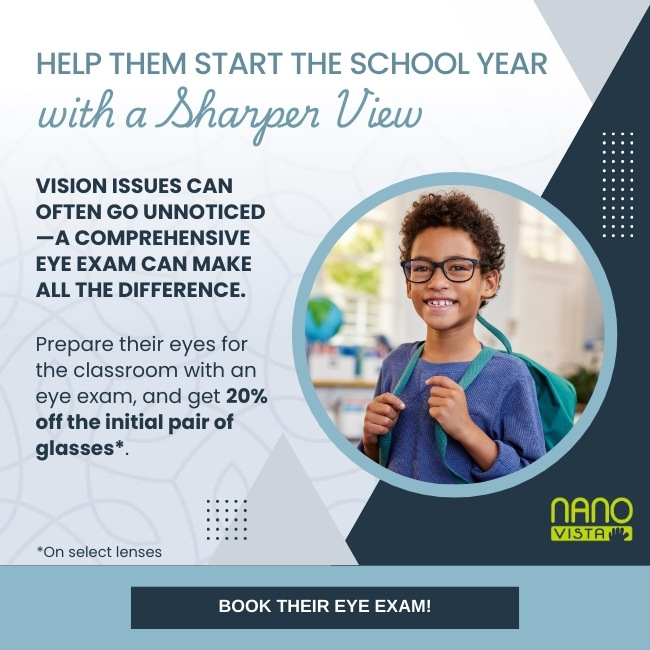Myopia or nearsightedness is a common vision condition and can be diagnosed by your optometrist during an eye exam. Most people are familiar with traditional methods of fixing nearsightedness, such as glasses or contact lenses. Standard prescription lenses help patients experience improved vision but don’t treat the condition.
Myopia control uses methods to prevent myopia progression. Although myopia cannot be reserved, slowing myopia is crucial for preserving sight and protecting eye health.
What is Myopia?
Myopia (nearsightedness) occurs when the eyeball is elongated, or the cornea is too steeply curved. Typically, myopia is detected in school-age children (6–18) and progresses until age 20. However, in some cases, nearsightedness can develop in adults because of visual stress or health conditions.
Myopia is a refractive error, as the atypical eye shape causes the eye to refract light incorrectly. Instead of focusing light on the retina (tissue at the back of the eye), the elongation causes light to reflect in front of the retina. As a result, myopic patients experience blurry distance vision.
Myopia Symptoms
Myopia symptoms can vary depending on the degree of myopia. However, common myopia symptoms include:
- Blurry distance vision
- Eyestrain
- Headaches
- Squinting to see distances
People with mild myopia might experience few symptoms and may not require corrective lenses for most tasks. Moderate to severe myopia often interferes with most visual tasks, from driving to watching TV. Higher degrees of myopia also increase risk factors for severe eye conditions, including:
What Is Myopia Control?
Myopia control uses methods to slow eye growth (axial elongation), preventing myopia from worsening. Although treatment cannot reverse myopia, reducing growth rate and prescription changes can benefit eye health long-term.
Myopia control primarily focuses on children, as myopia typically presents in children. By preventing axial elongation sooner, children are less likely to develop higher degrees of myopia.
Children that benefit from myopia control may still need to wear glasses or contact lenses, even into adulthood. The goal is to help them experience the best vision possible.
Some common myopia control methods include:
- Atropine eye drops
- Multifocal contact lenses
- Myopia control glasses
Atropine Eye Drops
Atropine eye drops have a long history in diagnosing eye health, as atropine is used for pupil dilation during an eye exam. Low-dose atropine eye drops can slow eye growth by relaxing focusing muscles inside the eye, the exact mechanisms that cause pupil dilation.
In nearly 90% of patients, myopia development reduces by about 50%. Notably, the sooner children begin atropine treatment, the less nearsighted they’ll be once eye growth settles (typically at age 20).
Low-dose atropine treatment is typically prescribed for children between 5–18 years old and administered for 2–3 years. The dose range is 0.01-0.05% atropine, although research favors the 0.05% dose results.
Side effects are uncommon, but patients can experience redness or itchiness around the eye. Additionally, a known effect of dilating the pupil is temporary blurry vision, which is why the drops are administered at bedtime.
Multifocal Contact Lenses
A multifocal contact or peripheral light defocus lens can improve vision and prevent myopia progression. The lens controls peripheral light to slow eye growth. Traditional (single-vision) lenses focus direct light, leaving peripheral light to focus behind the retina, stimulating eye growth. A multifocal lens can slow myopia progression by about 43% (when compared to traditional prescription lenses).
The first FDA-approved multifocal lenses, MiSight 1-day, feature zones designed like a bullseye. The center zone (middle of the bullseye) focuses light on the retina to correct vision. The outer zone (surrounding the bullseye center) redirects peripheral light rays to focus on the retina, slowing eye growth.
According to a study of MiSight 1-day lenses, the MiSight lenses contributed to:
- Reduced rate of eye elongation by 52%
- Reduced rate of myopia progression by 59%
Multifocal Glasses
Multifocal glasses have design features similar to multifocal contact lenses. The eyeglasses lens’ has a zone for correcting nearsightedness and a zone for redirecting peripheral light. Studies show myopia control eyeglasses can reduce progression by more than 60%.
Notably, there are no FDA-approved myopia control eyeglasses in the US. However, the Essilor Stellest lens earned FDA’s Breakthrough Device designation in 2021. Additionally, clinical trials have demonstrated the lens’ effectiveness, including slowing eye growth rate similar to non-myopic children.
Another option is the MiYOSMART lens by Hoya. The lens uses DIMS (Defocus Incorporated Multiple Segments) to create myopic defocus (redirecting peripheral light). A clinical trial found the MiYOSMART lenses reduced myopia progression by an average of 60%.
Contact Us for Myopia Control
Traditional single-vision corrective eyeglasses and contact lenses can make living with myopia comfortable right now. But myopia control can protect eye health long-term. Diagnosing and controlling myopia in children can help preserve their sight and eye health. We can help your child experience the best vision by managing myopia progression.Book an appointment with your optometrist at Dr. Shonah Finlay Doctors EyeCare today.




